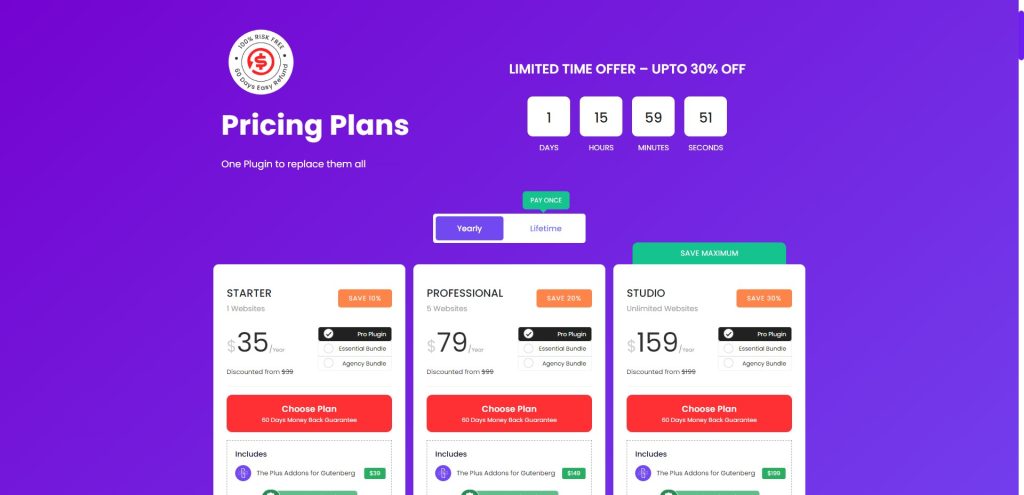When it comes to WordPress plugins, there are both free and premium options available. While free plugins can be great for personal use or small websites, businesses and eCommerce sites often require more advanced features and support. This is where premium plugins come in, offering additional features, priority support, documentation, and regular updates.
But who should pay for these premium plugins – you or your client?
It’s a question that many WordPress developers and agencies face.
On one hand, if you pay for the plugin subscription yourself, you have more control over the plugin and can ensure that it’s always up-to-date. On the other hand, if you charge your client for the plugin subscription, it can help offset your costs and potentially increase your profit margin.
There are pros and cons to both methods, and the best approach may vary depending on your specific business model and clientele.
In this article, I’ll explore the different factors to consider when deciding whether to pay for premium WordPress plugins yourself or charge your clients for them.
I’ll also discuss how to manage plugin subscriptions with client charge themes, as well as the potential drawbacks of this approach.
Table of Contents
What are Premium WordPress Plugins?
You might have come across the term “premium WordPress plugins.” But what exactly are they? In simple terms, premium WordPress plugins are paid versions of WordPress plugins that come with additional features, priority support, documentation, and regular updates.

Premium WordPress plugins are developed by third-party developers and are not available on the official WordPress repository. They are often sold on the developers’ websites or on marketplaces like CodeCanyon and Envato Elements or there own website.
Premium WordPress plugins often come with robust features that offer more functionalities than free plugins. They are also usually well-maintained and updated regularly to ensure compatibility with the latest version of WordPress and to fix any security issues.
However, premium WordPress plugins are not for everyone. They can be expensive, and not all users need the extra features they offer. Additionally, some premium plugins require an annual subscription fee, which can add up over time.
It’s important to weigh the pros and cons of using premium WordPress plugins before deciding whether they are right for you or your clients. In the next sections, we will discuss the different ways to manage plugin subscriptions and who should pay for them.
If you are just starting out with WordPress websites for your clients, then you should check out my detailed blog, where I have discussed everything you need to know – Read How to Manage.
Who Should Pay for Premium WordPress Plugins?
As managing multiple WordPress sites, I often get asked who should pay for premium WordPress plugins – the client or the business?
In my experience, the answer depends on several factors, including the nature of the project, the budget, and the client’s expectations. In this section, I will outline the pros and cons of both approaches to help you make an informed decision.
Pros of Clients Paying for Premium WordPress Plugins
When clients pay for premium WordPress plugins, they have more control over the project’s budget and can choose which plugins they want to use. This approach can also help clients feel more invested in the project and give them a sense of ownership. Additionally, clients who pay for premium plugins are more likely to appreciate their value and use them to their full potential.
Cons of Clients Paying for Premium WordPress Plugins
One potential downside of clients paying for premium WordPress plugins is that they may not fully understand the cost and value of each plugin. This lack of understanding can lead to overspending or underutilizing the plugins. Additionally, clients may be hesitant to pay for plugins they perceive as unnecessary or too expensive, even if they are critical for the project’s success.
Pros of You Paying for Premium WordPress Plugins
When the business pays for premium WordPress plugins, they have more control over which plugins are used and can ensure that all necessary plugins are purchased. This approach can also help the business maintain a consistent level of quality across all projects. Additionally, businesses that pay for premium plugins can use them across multiple projects, which can save money in the long run.
Cons of You Paying for Premium WordPress Plugins
One potential downside of the business paying for premium WordPress plugins is that clients may not fully appreciate their value or feel invested in the project. Additionally, businesses that pay for premium plugins may be tempted to overspend on unnecessary plugins or overlook the value of free plugins. Finally, managing plugin subscriptions can be time-consuming and require additional resources.
Are you Spending hours:
- Managing your WordPress website?
- Troubleshooting Technical difficulties?
- Dealing with plugin Security Issues?
- Website Uptime Monitoring?
- Cleaning Hacked Sites?
Let me take care of your WordPress website, so you can focus on scaling your agency.
Give your clients top-notch VPS Hosting for blazing fast performance, 24×7 security monitoring with autopilot safe plugin updates.
I will help you free up time by managing WordPress websites.
How to Manage Plugin Subscriptions with Client Charge Theme?
When it comes to managing plugin subscriptions with a client charge theme, there are a few things to consider. As a developer, I have worked with various clients and have found that there are pros and cons to both methods of managing plugin subscriptions.
Pros of Managing Plugin Subscriptions with Client Charge Theme
- Control over plugin costs: When you manage plugin subscriptions with a client charge theme, you have control over the costs. You can charge your clients for the plugins that they use, making it easier to manage your own costs.
- Increased revenue: By charging your clients for the plugins they use, you can increase your revenue. This can help you to grow your business and invest in new plugins or tools to improve your services.
- Better client communication: When you charge your clients for the plugins they use, it can lead to better communication. You can discuss the cost of the plugins and any potential issues that may arise, leading to a better relationship with your client.
Cons of Managing Plugin Subscriptions with Client Charge Theme
- Potential for client pushback: Some clients may push back on the idea of paying for plugins. They may feel that it is your responsibility as the developer to provide the plugins they need.
- Compatibility issues: Not all plugins are compatible with every theme. If you charge your clients for a plugin that is not compatible with their theme, it can lead to issues and frustration.
- Increased administration: Managing plugin subscriptions with a client charge theme can be time-consuming. You need to keep track of which plugins your clients are using and ensure that they are paying for them.
I have created a detailed comparison on Best 8 WordPress site management Tools, based on 40 + features. If you manage multiple websites, then this is a must-read for you.
Best Use Case
The best use case for managing plugin subscriptions with a client charge theme is when you have a good relationship with your client. If your client trusts you and understands the value of the plugins you are providing, they are more likely to be willing to pay for them.
As a developer, it is important to communicate the benefits of paying for plugins. Explain that it allows you to provide better services, and that the cost is necessary to cover your own expenses.
How to Make Clients Pay for Premium WordPress Plugins?
Let’s explore the pros and cons of each method, and the best use case based on my user research.
Method 1: Manage Plugin Subscriptions with Client Charge Theme
One way to handle premium plugin costs is to include them in your overall project estimate and charge the client for them. This method has a few advantages:
- It’s easy to manage all project costs in one place.
- The client knows upfront what they’re paying for.
- You can negotiate discounts for bulk purchases.
However, there are also some downsides:
- The client may be hesitant to pay for something they don’t understand.
- If the client decides not to renew their subscription, you may be stuck with the cost.
- It can be difficult to accurately estimate how many licenses you’ll need.
Method 2: Make Clients Pay Directly
Another option is to have the client purchase the premium plugins themselves, either through your recommendation or their own research. This method has some benefits:
- The client has control over their own website and can manage their own licenses.
- You don’t have to worry about managing plugin subscriptions.
- The client may feel more invested in their website if they’ve paid for the plugins themselves.
However, there are also some downsides:
- The client may not be comfortable making payments directly.
- It can be difficult to ensure that the client purchases the correct plugin and license.
- You may lose out on potential discounts for bulk purchases.
Do you know heavy images can slow down your client’s websites, I have shared 1 free way to optimize your WordPress images in bulk for Free – See How
Best Use Case
After conducting user research, I found that the best use case for managing plugin subscriptions with client charge theme is for small businesses or businesses with limited budgets. This method allows for easy cost management and negotiation, without overwhelming the client with additional payments.
On the other hand, making clients pay directly may be a better option for larger businesses with more resources and experience handling payments and subscriptions.
Conclusion
In conclusion, the decision of who should pay for premium WordPress plugins ultimately depends on the specific project and client. By understanding the pros and cons of each method and considering the best use case, you can make an informed decision that works for both you and your client.
I share my Learnings & Case studies via email.
Subscribe to Stay Updated
Frequently Asked Questions
How to Choose the Right WordPress Plugin for Your Site?
When it comes to choosing the right WordPress plugin for your site, there are a few things to keep in mind. First, make sure the plugin is reputable and has good reviews. Check to see if it is regularly updated and if it is compatible with your version of WordPress. Also, consider the features you need and make sure the plugin offers those features.
How to Install and Activate WordPress Plugins for Clients?
There are multiple ways to install a WordPress plugin for your client. One way is to go to the Plugins section in the WordPress dashboard and click on the “Add New” button. From there, you can search for the desired plugin using keywords or browse through the Featured, Popular, or Recommended sections. Once you find the plugin, click on the “Install Now” button and then the “Activate” button to activate it on your client’s website. Another way is to manually download the plugin from the WordPress repository or the developer’s website and then upload it to the client’s website using FTP or cPanel.
What are some best practices for installing and managing WordPress plugins for clients?
Some best practices for installing and managing WordPress plugins for clients include:
1) Only install plugins that are necessary for the website’s functionality and performance.
2) Keep the plugins updated to ensure compatibility with the latest version of WordPress and to avoid security vulnerabilities.
3) Test the plugins on a staging site before installing them on the live site to avoid any conflicts or issues.
4) Use trusted sources for downloading and installing plugins, such as the WordPress repository or reputable developers.
5) Monitor the website’s performance and security after installing new plugins to ensure they are not causing any issues.
